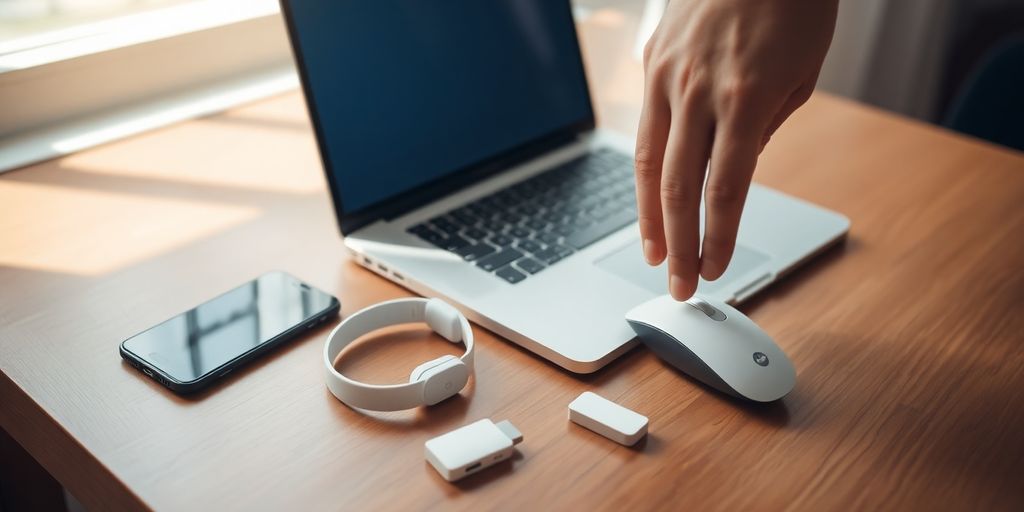
I tried setting up audiomack download for pc last weekend, and it wasn’t as straightforward as I first thought. There are a few things to check and steps to follow, whether you’re using Windows directly or an Android emulator. This guide will walk you through the whole process—system checks, installation, emulator setup, offline syncing, sound tweaks, and even a bit on how to fix any hiccups.
Key Takeaways
- Check that your PC runs a supported Windows version, has enough RAM and disk space, and a solid internet link before starting audiomack download for pc.
- Grab the installer from Audiomack’s official site, run it with the right permissions, and finish the setup wizard for a smooth install.
- If you go the emulator route, pick a reliable one like BlueStacks or Nox, boost its performance, then add Audiomack inside it.
- Learn how to grab tracks and playlists for offline listening, sort your local library, and tweak storage and download settings.
- Know how to fix install glitches, playback or download failures, and where to turn for help—Audiomack support or community forums.
Reviewing System Requirements For Audiomack Download For PC

Before you jump into enjoying Audiomack on your PC, it’s important to make sure your system can actually handle it. Nobody wants a laggy, frustrating experience, right? So, let’s break down what you need to check.
Verifying Windows Compatibility
First things first, you need to know what version of Windows you’re running. Audiomack generally works best with Windows 7 and up. Older versions might cause issues, or not even work at all. To check, just type "System Information" in your Windows search bar and open the app. Look for the "OS Name" and "Version" entries. If you’re on an older OS, it might be time for an upgrade to ensure smooth Audiomack Creator-Upload Music playback.
Checking Hardware And Memory Specifications
Okay, so your Windows version is good. Now, let’s talk about the guts of your computer. You’ll want to make sure you have enough RAM and a decent processor. Here’s a general idea:
- Processor: A dual-core processor should be sufficient, but a quad-core is better for multitasking.
- RAM: At least 4GB of RAM is recommended, but 8GB is ideal, especially if you plan on running other programs at the same time.
- Graphics Card: A dedicated graphics card isn’t strictly necessary, but it can help with overall performance, especially if you’re using an emulator.
It’s worth noting that if you’re planning on using an Android emulator to run Audiomack, the emulator itself will also have its own system requirements. Make sure to check those as well!
Ensuring Network And Storage Availability
Finally, let’s talk about your internet connection and storage space. Audiomack is a streaming service, so a stable internet connection is a must. A broadband connection (cable, DSL, or fiber) is recommended. As for storage, you’ll need enough space to download songs for offline listening. The amount you need depends on how many songs you plan to download, but it’s always good to have some extra space available. I’d say at least 10GB free on your hard drive is a good starting point. If you plan to download a lot of music, consider more. Also, make sure your Audiomack download for PC has enough space to operate smoothly.
Installing Audiomack Download For PC On Windows
Downloading From The Official Source
Okay, so you’re ready to get Audiomack on your Windows PC. The first thing you absolutely need to do is make sure you’re downloading from a safe, official source. There are a lot of shady websites out there that might try to trick you into downloading malware disguised as the Audiomack App. Don’t fall for it!
- Go directly to the Audiomack website, if they offer a desktop version.
- Look for a verified download link. It usually has a little checkmark or something similar to show it’s legit.
- Double-check the URL to make sure it’s the real deal. Typos are a classic trick used by scammers.
Getting the installer from the right place is half the battle. It saves you from headaches later on. Trust me, I’ve learned this the hard way with other software. Nothing is worse than spending hours cleaning up a virus because you were too impatient to find the official download.
Configuring Installer Permissions
Once you’ve got the installer, you’re not quite done yet. Windows can be a bit picky about what it lets you install, so you might need to tweak the permissions. Right-clicking the installer and selecting "Run as administrator" is often the key. This gives the installer the necessary privileges to make changes to your system. If you skip this step, you might run into errors later on.
Here’s a quick rundown of what you might see and what to do:
- User Account Control (UAC) prompt: This is Windows asking if you really want to let the program make changes. Say yes (assuming you trust the source, which you should if you followed the previous step!).
- Installer asking for specific permissions: Pay attention to what the installer is asking for. If it seems fishy (like asking for access to your camera or microphone when it shouldn’t), be cautious.
- Antivirus software flagging the installer: This doesn’t always mean it’s bad, but it’s worth investigating. Make sure your antivirus software is up to date and run a scan of the installer file before proceeding.
Completing The Setup Wizard
Alright, you’ve got the installer, you’ve got the permissions sorted, now it’s time to actually install Audiomack. The setup wizard should guide you through the process, but here are a few things to keep in mind:
- Read the license agreement: I know, nobody actually reads these, but it’s a good idea to at least skim it. It tells you what you’re agreeing to.
- Choose the installation location: The default location is usually fine, but if you have limited space on your C: drive, you might want to choose a different location.
- Create a desktop shortcut: This makes it easier to launch Audiomack later on. It’s usually checked by default, but make sure it is.
| Setting | Recommendation | Reason |
|---|---|---|
| Installation Folder | Default (unless space is an issue) | Keeps things organized; easier to find if you need to uninstall later. |
| Desktop Shortcut | Yes | Quick access to the app. |
| Start Menu Entry | Yes | Makes the app searchable in the Start Menu. |
Once the installation is complete, launch Audiomack and start enjoying your music! If you run into any problems, check the troubleshooting section later in this guide.
Setting Up Emulator For Audiomack Download For PC
So, you want to run Audiomack on your PC but there’s no native app? No problem! Emulators are the way to go. They let you run Android apps on your computer. It’s like having an Android phone inside your PC. Here’s how to get it set up.
Choosing The Right Android Emulator
There are a bunch of Android emulators out there, and picking the right one can make a big difference. Some are resource-heavy, while others are lighter and faster. Popular choices include BlueStacks, Nox Player, and Memu Play. I’ve had good experiences with BlueStacks, but it can be a bit demanding on your system. Nox Player is another solid option, known for its stability. Ultimately, the best emulator depends on your PC’s specs and what you’re looking for in terms of features. Consider trying a few to see which one works best for you. For example, you can install LDPlayer and see if it works for you.
Optimizing Emulator Performance
Once you’ve picked an emulator, you’ll want to tweak it for the best performance. Emulators can be resource hogs, so optimization is key. Here are a few things you can do:
- Allocate more RAM: Give the emulator enough memory to run smoothly. Usually, 2GB to 4GB is a good starting point, depending on your PC’s total RAM.
- Enable Virtualization: Make sure virtualization is enabled in your BIOS settings. This can significantly improve emulator performance.
- Update Graphics Drivers: Keep your graphics drivers up to date. This can help with graphical glitches and improve overall performance.
- Adjust Resolution: Lowering the emulator’s resolution can reduce the load on your system.
It’s worth noting that some emulators have specific settings for optimizing performance. Take some time to explore the settings menu and see what options are available. Experiment with different configurations to find what works best for your setup.
Installing Audiomack Within The Emulator
Now for the fun part: installing Audiomack! Once your emulator is up and running, it’s just like using an Android phone. Open the Google Play Store, search for "Audiomack," and click install. After it’s installed, you can open the app and log in with your account. You can even find an Audiomack unblocked version if you are having issues with the regular version. Now you can stream and download music just like you would on your phone. Enjoy!
Exploring Features Of Audiomack Download For PC
Navigating The Main Dashboard
Okay, so you’ve got Audiomack up and running on your PC. Now what? The first thing you’ll see is the main dashboard. It’s pretty straightforward, but let’s break it down. You’ll usually find a mix of trending music, curated playlists, and new releases right up front. The search bar is your best friend – it’s usually at the top, ready for you to type in whatever artist, song, or album you’re looking for. On the side, you’ll see options like "Trending," "New Music," and "Genres." It’s all pretty intuitive, but take a few minutes to click around and get a feel for where everything is.
Customizing Theme And Layout
One cool thing about Audiomack is that you can tweak how it looks. I mean, who doesn’t like a little personalization? You can usually find theme options in the settings menu. Some people prefer a dark theme, which is easier on the eyes, especially at night. Others like a light theme. It’s all about what you like best. As for the layout, you might be able to adjust things like the size of album art or how playlists are displayed. It’s not always super customizable, but even small changes can make a big difference in how you experience the app. I like to download Audiomack app and play around with the settings until it feels just right.
Accessing User Profile And Playback Controls
Your user profile is where you can manage your account, see your followers, and check out your own uploads (if you’re an artist, that is). The playback controls are, of course, how you control the music. You’ve got the usual play, pause, skip, and volume controls. But Audiomack often has some extra goodies too.
- A repeat button (to play a song or playlist over and over).
- A shuffle button (to mix things up).
- A queue feature (to line up songs you want to hear next).
Don’t forget to explore the settings menu within the playback controls. You might find options to adjust the playback quality or enable gapless playback. These little tweaks can really improve your listening experience.
And here’s a quick table showing some common playback control shortcuts:
| Action | Shortcut |
|---|---|
| Play/Pause | Spacebar |
| Skip Forward | Right Arrow |
| Skip Backward | Left Arrow |
Managing Offline Content In Audiomack Download For PC

Having your favorite music available offline is a game-changer, especially when you’re on the go or dealing with spotty internet. Audiomack makes it pretty easy to manage your downloaded content, so let’s get into how to make the most of it.
Downloading Tracks And Playlists
Downloading music on Audiomack is super straightforward. Just find the track or playlist you want, and look for the download icon (usually an arrow pointing downwards). Tap it, and the download starts. For playlists, downloading saves all the tracks within that playlist for offline listening. Keep in mind that some artists might disable downloads for their tracks, so you won’t always see the option. Also, premium users often get higher quality downloads, which is a nice perk.
Organizing The Local Library
Once you’ve downloaded a bunch of tracks, keeping things organized is key. Audiomack automatically sorts your downloads, but you can also create your own playlists to group songs by mood, genre, or whatever makes sense to you.
Here’s a simple way to think about it:
- Automatic Sorting: By artist, album, or date downloaded.
- Custom Playlists: Create playlists for different activities (workout, chill, etc.).
- Smart Playlists: (If available) Automatically update based on criteria like most played or recently added.
It’s a good idea to periodically clean up your downloads. Delete tracks you no longer listen to, or move them to a different playlist if you want to keep them but don’t listen often. This helps keep your library manageable and saves storage space.
Adjusting Storage And Download Preferences
Audiomack lets you tweak how it handles storage and downloads. You can choose where your downloads are saved (internal storage or SD card, if you have one), and you can also set limits on download quality to save space. To find these settings, usually you have to go to the app’s settings menu and look for something like "Download Settings" or "Storage".
Here’s what you might find:
- Storage Location: Choose where to save downloads.
- Download Quality: Select between different quality levels (High, Medium, Low).
- Clear Cache: Remove temporary files to free up space.
Making sure these settings are dialed in can really improve your offline listening experience and keep your device running smoothly.
Optimizing Audio Settings In Audiomack Download For PC
Let’s be real, nobody wants their music sounding like it’s coming from a tin can. Getting the audio settings right in Audiomack on your PC can seriously change your listening experience. It’s not just about blasting the volume; it’s about making sure everything sounds crisp and clear, whether you’re using headphones or external speakers. So, let’s get into how to tweak those settings and make your music sound its absolute best.
Adjusting Equalizer Presets
Audiomack usually has some built-in equalizer presets that you can play around with. These are designed to quickly adjust the sound for different music styles. You might see options like "Rock," "Pop," "Classical," or "Hip-Hop." Experiment with these to see which one sounds best for the type of music you’re listening to. Don’t be afraid to try them all out, even if they don’t seem like the obvious choice. Sometimes, the "Rock" preset can make your electronic music sound surprisingly good. If you’re not happy with the presets, you might be able to create your own custom EQ settings, depending on the version of Audiomack App you’re using.
Enabling High-Quality Streaming
If you’re serious about sound quality, you’ll want to make sure you’ve enabled high-quality streaming. This usually means going into the settings menu and finding an option that says something like "High Quality Audio" or "Maximum Streaming Quality." Keep in mind that streaming at a higher quality will use more data, so if you’re on a limited data plan, you might want to stick with the standard quality. But if you’re on Wi-Fi and want the best possible sound, crank it up! Here’s a quick comparison:
| Quality Setting | Data Usage (per hour) | Audio Quality |
|---|---|---|
| Low | 50 MB | Basic |
| Standard | 100 MB | Good |
| High | 150 MB | Excellent |
Integrating External Audio Devices
If you’re using external speakers or headphones, you’ll want to make sure Audiomack is properly set up to use them. This usually involves going into your computer’s sound settings and selecting the correct output device. On Windows, you can do this by right-clicking the speaker icon in the system tray and choosing "Open Sound settings." From there, you can select your preferred output device. Also, make sure that your Audiomack download for PC recognizes the device. Sometimes, you might need to restart Audiomack after connecting a new audio device for it to be recognized.
Getting your audio settings dialed in can make a huge difference. It’s worth spending a few minutes to experiment and find what sounds best to you. After all, music is meant to be enjoyed, and having the right settings can really bring out the best in your favorite tracks.
Here are some things to consider:
- Check your device’s volume levels. Sometimes the problem isn’t Audiomack, but just a low volume setting on your computer or headphones.
- Make sure your audio drivers are up to date. Outdated drivers can sometimes cause audio issues.
- Experiment with different headphones or speakers to see if that makes a difference. Sometimes, the problem is with the audio equipment itself.
Troubleshooting Audiomack Download For PC Issues
Resolving Installation Errors
Okay, so you’re trying to get Audiomack on your PC, and it’s throwing errors at you? Super frustrating, I get it. First, double-check that you actually meet the system requirements. Sometimes, it’s as simple as needing a newer version of Windows or not having enough space. If you’re using an emulator, make sure it’s up-to-date. Old emulator versions can cause all sorts of weird problems. Also, temporarily disable your antivirus software during the installation. I know, it sounds scary, but sometimes antivirus programs can interfere with the installation process. Just remember to turn it back on afterward!
- Check your internet connection. A stable connection is needed for downloading the installer.
- Run the installer as administrator. Right-click the installer file and select "Run as administrator."
- Clear temporary files. Press Windows key + R, type
%temp%, and delete the contents of the folder.
Installation errors can be a real headache, but usually, they’re caused by something simple. Don’t give up! Take it one step at a time, and you’ll get there.
Fixing Playback And Download Failures
So, you’ve got Audiomack installed, but now the music won’t play or downloads are failing? Annoying! First, check your internet connection again. Streaming and downloading need a solid connection. If your internet is fine, try clearing the app’s cache. In the emulator settings, there should be an option to clear cache and data. This can often fix weird playback issues. Also, make sure you have enough storage space on your PC. If your hard drive is full, Audiomack won’t be able to download anything.
- Restart the Audiomack app.
- Reinstall the app if the problem persists.
- Check for app updates in the emulator’s app store.
Contacting Support And Community Resources
Alright, you’ve tried everything, and nothing’s working? Time to call in the experts. The Audiomack website should have a support section with FAQs and contact information. Don’t be afraid to reach out to them directly. Also, check out online forums and communities related to Audiomack or your emulator. Other users might have experienced the same problems and found solutions. You can often find helpful tips and tricks in these communities. Sometimes, just describing your problem to someone else can help you figure out the solution. Plus, there are tons of Audiomack videos online that might help.
- Visit the official Audiomack website for support.
- Search for Audiomack forums or communities on Reddit or other platforms.
- Check the emulator’s website for troubleshooting guides.
## Conclusion
All in all, setting up Audiomack on your PC may seem a bit fiddly at first. You’ll need to grab an emulator, tweak a few settings, and sign in. Once you’re past that, though, you get the full app on a big screen—no more squinting at your phone when you search for tracks. I’ll admit I ran into a crash or two with BlueStacks at the start, but a quick update sorted it out. Now my playlists load in seconds and offline listening is a breeze. If you hit a snag, just take a breather and follow the steps again. Give it a spin and let the music play!
Frequently Asked Questions
Do I need an emulator to run Audiomack on my PC?
Yes. Since Audiomack is made for mobile, you’ll need an Android emulator like BlueStacks or Nox to use it on Windows. The emulator acts like a phone on your computer.
Can I download songs and playlists for offline listening?
Absolutely. After you log in, just tap the download button next to a song or playlist. Then you can listen without the internet.
Is Audiomack free to use on my computer?
Yes, the app and its main features are free. You can stream, download, and make playlists at no cost. Some extras may require a small fee.
How much space does Audiomack need on my PC?
The app itself takes up about 200–300 MB. Each downloaded track uses around 3–5 MB, so plan your storage based on how many songs you save.
What if the installer won’t start or shows an error?
First, check that your Windows is up to date. Then run the emulator or installer as an administrator. If it still fails, try redownloading from the official site.
Can I use the same Audiomack account on PC and mobile?
Yes. Just sign in with your usual username and password. All your saved songs, playlists, and follows will sync across devices.





